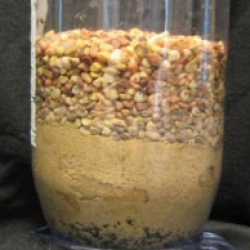Source Institutions
Source Institutions
Add to list Go to activity
Activity link broken? See if it's at the internet archive

In this activity, learners consider the water features they might enjoy at a community park--a pond, brook, water playground (or "sprayground"), or pool--and what happens to the water over time. In small groups, they explore and test common materials to identify the best low-tech materials that can be used to help filter water. This activity is part of a curriculum designed to engage learners in hands-on engineering challenges.
- 10 to 30 minutes
- 10 to 30 minutes
- Over $20 per group of students
- Ages 4 - 14
- Activity, Demonstration, Lesson/Lesson Plan, Model
- English
Quick Guide
Materials List (per group of students)
- computer, speakers, projector, projection screen, and access to the Internet (optional)
- a writing surface where the groups may sketch and write (optional)
- 5–6 (2-L) empty, clear plastic water bottles with the label and cap removed (preferably cleaned and repurposed for this activity)
- 1 (16-oz. or larger) clear plastic container, such as a measuring cup
- 10 rubber bands
- 10 or more (~10" × 5") pieces of silk and/or cotton knit fabric, such as clean, discarded clothing or scraps from a fabric store
- 6 cups of play sand
- 5 cups of small aquarium gravel
- 10 (~1") chunks of lava rock
- 4 cups activated carbon/charcoal (sold at aquarium supply stores)
- a selection of additional filtration materials to choose from, such as 1 cup of rice, 30 (5/8") marbles, 30 non-biodegradable Styrofoam "peanuts," 10 (1"x1") pieces of synthetic sponge, 1 package of cotton balls, 10 (5"x5") pieces of quilt batting, 2 cups shredded paper, 10 coffee filters
- ~2 teaspoons of tea leaves (or the contents of 3–4 tea bags)
- 3 cups boiling hot water
- 1 (1-quart) tea pot or Pyrex measuring cup
- 2 or more (~1-cup) containers for holding and pouring “dirty water,” such as measuring cups (preferably with spouts for easy pouring) or clean, empty personal water bottles
- 2 or more labels or pieces of masking tape
- 6 teaspoons or medicine droppers
- 6 empty jars, pitchers, or other containers for collecting filtered water for later disposal
- microscope, microscope slides, and water samples collected from a park fountain, stream, pond, or lake (optional)
- 15–20 aprons or trash bags to wear over clothing
- Safety signs, which read “Be safe! Do not drink this water”
- 1 (8½" × 11") Be Creative…Be an Engineer! poster (for tweens, teens, and adults)
- 1 (8½" × 11") Grand Challenges of Engineering poster (for teens and adults) (optional)
- 1–2 (36" × 3 yards) packages of cheesecloth, purchased from a supermarket or kitchenware store
Subjects
-
Earth and Space Science
-
Earth Structure
- Oceans and Water
-
Earth Structure
-
Engineering and Technology
-
Engineering
- Bioengineering/Biomedical Engineering
- Civil Engineering
- Environmental Engineering
-
Technology
- Agriculture and Biotechnology
-
Engineering
-
Life Sciences
-
Ecology
- Human Impact
-
Ecology
-
The Nature of Science
-
The Scientific Process
- About Inquiry
- Asking Questions
- Conducting Investigations
- Science as a Career
-
The Scientific Process
-
The Nature of Technology
-
Technology and Society
- Impacts of Technology
- Technology and the Environment
-
The Design Process
- Research and Development
- Invention and Innovation
- Problem Solving
- Troubleshooting and Maintenance
-
Technology and Society
Informal Categories
- Nature and Environment
Audience
To use this activity, learners need to:
- see
- touch
Learning styles supported:
- Involves teamwork and communication skills
- Uses STEM to solve real-world problems
- Involves hands-on or lab activities
Other
Components that are part of this resource:
Includes alignment to state and/or national standards:
This resource is part of:
Access Rights:
- Free access
By:
- Department of Education and Public Outreach, Lunar and Planetary Institute; STAR Library Education Network
Rights:
Funding Source:
- NSF, DRL-1010844
